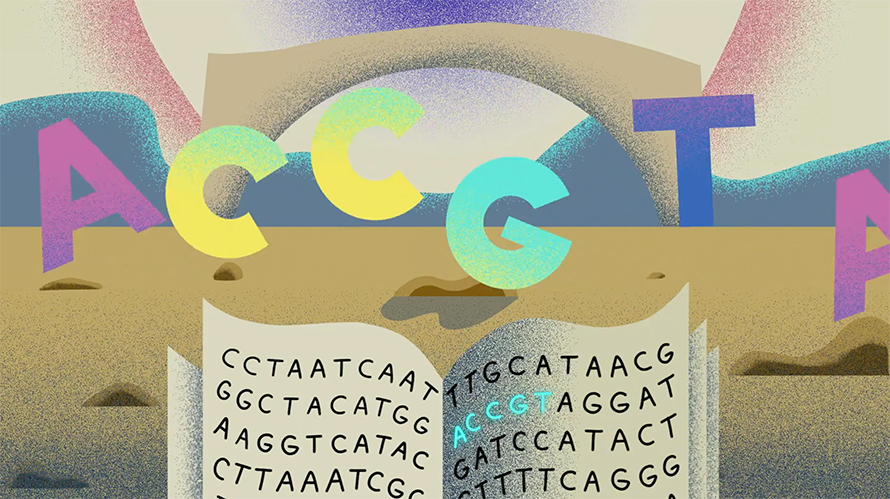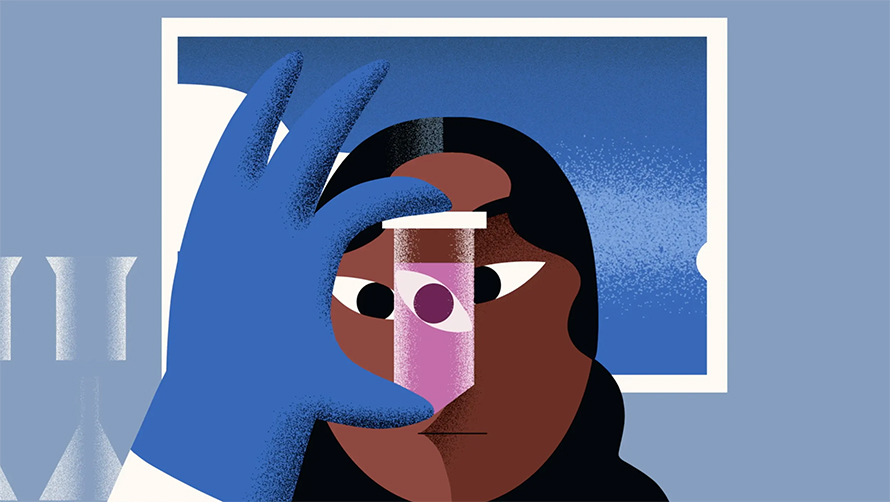The NIH is turning the human reference genome into a pangenome
In 2000, the human genome was announced as completed. But it wasn't. The "finished" genome was filled with gaps, and was not representative of humanity's genetic diversity.
Now, the job is being finished and the end is in sight. Massive partnered with the National Human Genome Research Institute to create The Human Pangenome, a short film about updates to the human reference genome. We spoke with the creative team behind the animated film to learn more about their process. This interview has been edited for length and clarity.
Why create this project right now? Why is this the right time?
Prabarna Ganguly, Staff Science Writer, NHGRI: Genomicists know that the reference genome is ALMOST complete — gaps still remain. In recent years, researchers at the National Human Genome Research Institute have been tackling two critical issues associated with the reference human genome. One: complete the genome — make it gapless — done by the Telomere-to-Telomere consortium (T2T). Two: generate reference sequences that embody all of human diversity — for all ancestral groups — done by the Human Genome Reference Program (HGRP).
The time to share this info is because the projects are building milestones that will impact future genomics efforts. The X chromosome was completely sequenced for the first time in June. By informing the public now, we can help them stay informed of these incredible changes taking place in the field of genomics—a complete genome and true representation of humankind.
What unexpected things did you learn during the creation of the video?
Harriet Bailey, Producer: So many things! I generally like to find explainer videos on topics when I start out a project, only there weren't any on the pangenome, so I realized that this will be the first out there. We started the video with an ad that was placed in The Buffalo News — someone had posted it on Twitter and it was fairly innocuous-looking — yet it was for this global research project that has had an incredible influence on science, medicine, and the human imagination, the "moonshot of biology," as Prabarna said. Which goes to show why you should (or shouldn't!) answer ads in local papers.
Another fact is about the makeup of the reference genome that the HGRP is aiming to update — the reference is a mosaic of over 20 genomes from various clone libraries and DNA from volunteers but the largest part — some 70 percent — is from one person in Buffalo and they were an African American male. I think a lot of people assume the reference genome is mostly of European ancestry, which just goes to show that we need to be extra careful about our assumptions when using these datasets, especially around the concept of race (which has no scientific basis, but that's for another video).
Were there specific misconceptions you set out to debunk?
HB: Sure, some were obvious but maybe there are others that are personal to each viewers' experience. The main misconception is that the Human Genome Project (HGP) is 100 percent sequenced. The 2000 announcement was for a draft of the sequence and covered about 95 to 99 percent of the human genome (depending on who you ask) so there were millions of base pairs remaining. We were left with the hardest bits to sequence — in fact, we didn't have the technology yet that could handle the long sections of repeating DNA so it was as complete as the early noughties could make it. Now we're talking about nano polishing genomes with vastly more sophisticated technology so a truly complete and error-free genome is within reach. Another point to make is that the projects we're talking about — the HGRP and T2T — won't be the final say in the human blueprint. There'll never really be an end to trying to determine all the base pairs that encoded all of humanity — that literally takes all of humanity — so all we're doing is creating a wider net.

How did you go about representing abstract concepts in science and biology?
HB: We wanted to create a unifying theme throughout the piece so we could thread together ideas whilst exploring these new research directions. The notion of every human having a book written in A, T, C, and Gs that is their genome is a well-known analogy and we wanted to use this familiar imagery to lead people into more of the more complex ideas. Analogies can only get you so far before they break down so it's important to know when to stop. Rosanna created a gorgeous immersive landscape and visual style that weaves in very tangible and recognizable events and objects into this dreamscape of scientific potential across multiple scales — from nucleotides to space. I hope the viewer watches feeling informed yet curious — maybe some visual ideas are open to interpretation and I'd love these videos to be used as primers for discussion.
Rosanna Wan, Animator: Harriet and Prabarna had already covered a lot of groundwork with visual ideas and motifs in the script, and their initial storyboards (the genome reference sequence book was always a key motif) — I rounded some of these out and filled in some gaps. A lot of the time in science communication, you're trying to find succinct visual metaphors that are immediately recognizable/relatable to a wider audience while retaining a level of accuracy to the science. Sometimes it works through a visual analogy, other times in the personification of objects, and sometimes things can be really literal, but finding an unusual way to stage its composition can create a deeper engagement between the viewer and the scene.
Why is it important to create public awareness around topics in genomics?
RW: Genomics are inherently a part of all of us (as it goes without saying!) — the research going into it determines significant medical and health decisions that affect all of us, so that's an important talking point, that also goes part in parcel with wider social issues on race, gender, and the inclusivity of research and design concerning these areas — I learned a lot from this project and hope that it can help communicate and maybe promulgate more work around subjects in genomics.
I think animation in science communication has really taken off because it can be a very effective way to make complex subjects accessible. It's a really fluid medium, so it can be direct and instructional, but you can also create relatable analogies where the subject is more abstract or hermetic, and you can transition between these states so easily to tell what you need.
HB: Genomics is an incredibly personal science that has the potential to be highly beneficial but is also highly intrusive. Without accurate knowledge about how genomic research works and what data is being used to validate theories, we can't interrogate how projects are put into action and what it means for an individual for the results to be implemented. Genomics is able to dismantle dangerous concepts such as eugenics but it requires pressure from an informed public. By being open about what science is capable of we can have honest and productive conversations about what we should use it for. On a personal level, I would love to see people explore scientific ideas through other mediums and systems of understanding. If the ultimate goal of the HGP is to classify humanity then I think art needs to be involved.
PG: It gives people the tools to make informed decisions about their lives since genomics is entrenched in almost all spheres of medicine. There is nothing more personal than our bodies. Genomics is still a young field and there are many things that will evolve over the decades, and debates in the field will have direct impacts on us. For example, there is an active discussion about the use of racial constructs when studying human populations in genomic studies. What comes of such scientific discourse will be worth paying attention to.
How did you create the mood for the art and video? What were some of your inspirations?
RW: As the topic is one that's grandiose and fundamental, I wanted the tone of the film to reflect this timeless atmosphere. Seeing how the book motif runs throughout the film, 'The Color of Pomegranates' immediately came to mind — there's a scene where all these large tomes are laid out with their pages flicking through from the wind. Another major inspiration was Emil Bisttram, who painted surreal scenes attempting to convey deep universal truths connecting elements of science, philosophy, and spiritualism, which I thought made a lot of sense concerning the subject matter, and likewise with Hilma af Klint's grand abstract compositions. I also like to run with core concepts that determine a sort of internal logic for the film — here it was the idea of puzzle pieces, or pieces of a whole, coming together, hence the modernist-like Paul Klee-ish faces and use of jigsaw-like scenes.

Harriet, You talked a bit about the feeling you had in 2000 [Ed: in a previous conversation], watching a meeting of the president with Francis Collins, Craig Venter, and with Tony Blair on video, I was hoping you could elaborate a bit on that.
HB: Ah yes, when I was 5 years old... I remember the project being a Big Deal. I lived in Cambridge, UK at the time and my dad is a biochemist so I was exposed to the HGP more than most. There was an excitement that surrounded it — you felt like something major was underway. I don't remember the announcement itself but watched it in my research and you have Bill Clinton flanked by rivals Francis Collins and Craig Venter and linked up to Tony Blair in the UK via a clunky satellite TV. The scene is so dated, the title screen is in acid green proto-Papyrus font, which I'm sure someone looked at and thought "future." And that was only really the beginning of genomic research — to see how far we've come with these ideas in 20 years makes my heart jump for the future (in a roller coaster dropping and also excitement welling kind of way). I wonder what the next scientific breakthrough that warrants an international video address from the President will be? Oh, wait, I know, a vaccine...
Enjoy reading ASBMB Today?
Become a member to receive the print edition four times a year and the digital edition monthly.
Learn moreGet the latest from ASBMB Today
Enter your email address, and we’ll send you a weekly email with recent articles, interviews and more.
Latest in Science
Science highlights or most popular articles

Mining microbes for rare earth solutions
Joseph Cotruvo, Jr., will receive the ASBMB Mildred Cohn Young Investigator Award at the ASBMB Annual Meeting, March 7–10, just outside of Washington, D.C.

Fueling healthier aging, connecting metabolism stress and time
Biochemist Melanie McReynolds investigates how metabolism and stress shape the aging process. Her research on NAD+, a molecule central to cellular energy, reveals how maintaining its balance could promote healthier, longer lives.

Mapping proteins, one side chain at a time
Roland Dunbrack Jr. will receive the ASBMB DeLano Award for Computational Biosciences at the ASBMB Annual Meeting, March 7–10, just outside of Washington, D.C.

Exploring the link between lipids and longevity
Meng Wang will present her work on metabolism and aging at the ASBMB Annual Meeting, March 7-10, just outside of Washington, D.C.

Defining a ‘crucial gatekeeper’ of lipid metabolism
George Carman receives the Herbert Tabor Research Award at the ASBMB Annual Meeting, March 7–10, just outside of Washington, D.C.

The science of staying strong
Muscles power every movement, but they also tell the story of aging itself. Scientists are uncovering how strength fades, why some species resist it and what lifestyle and molecular clues could help preserve muscle health for life.

